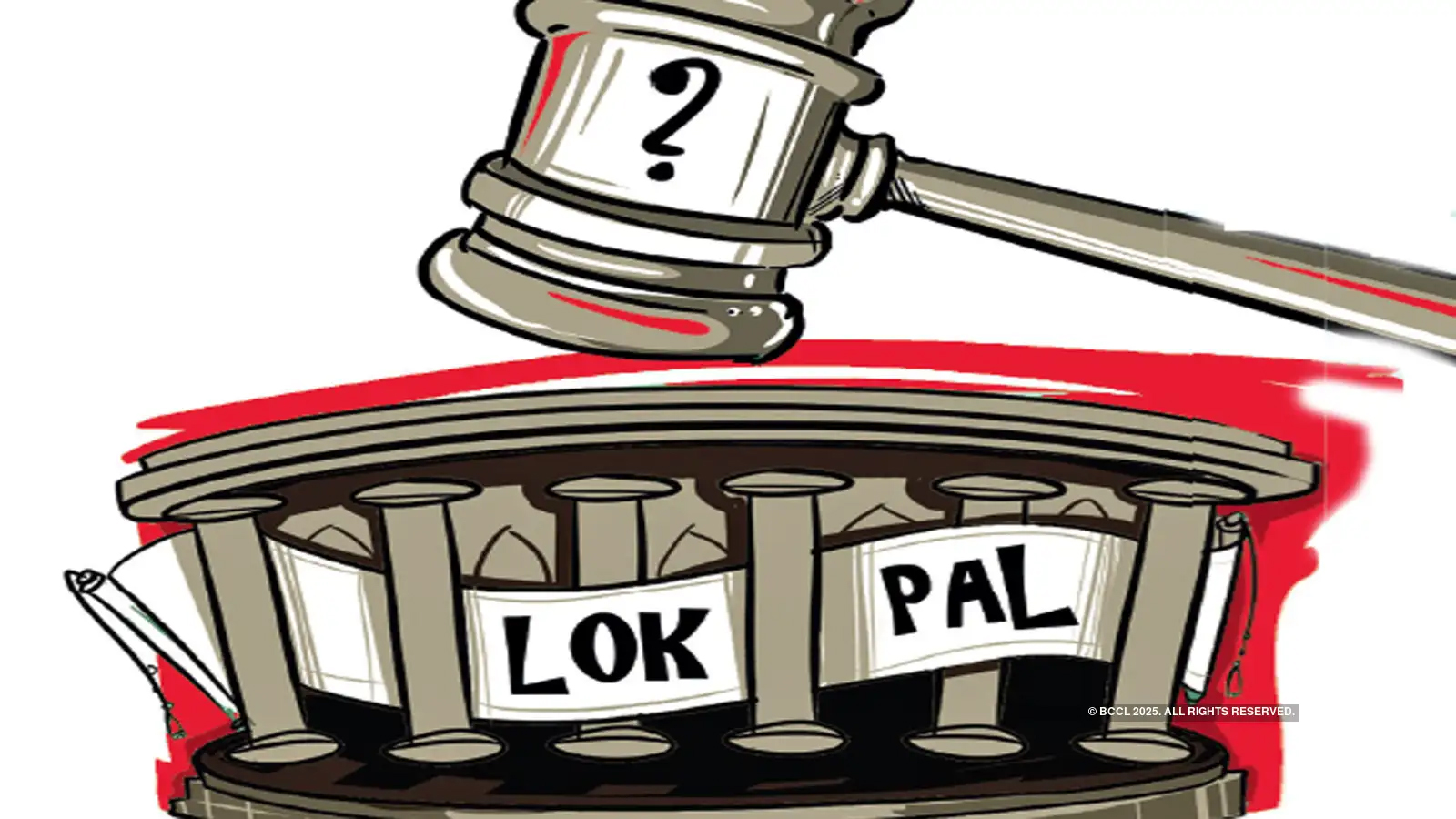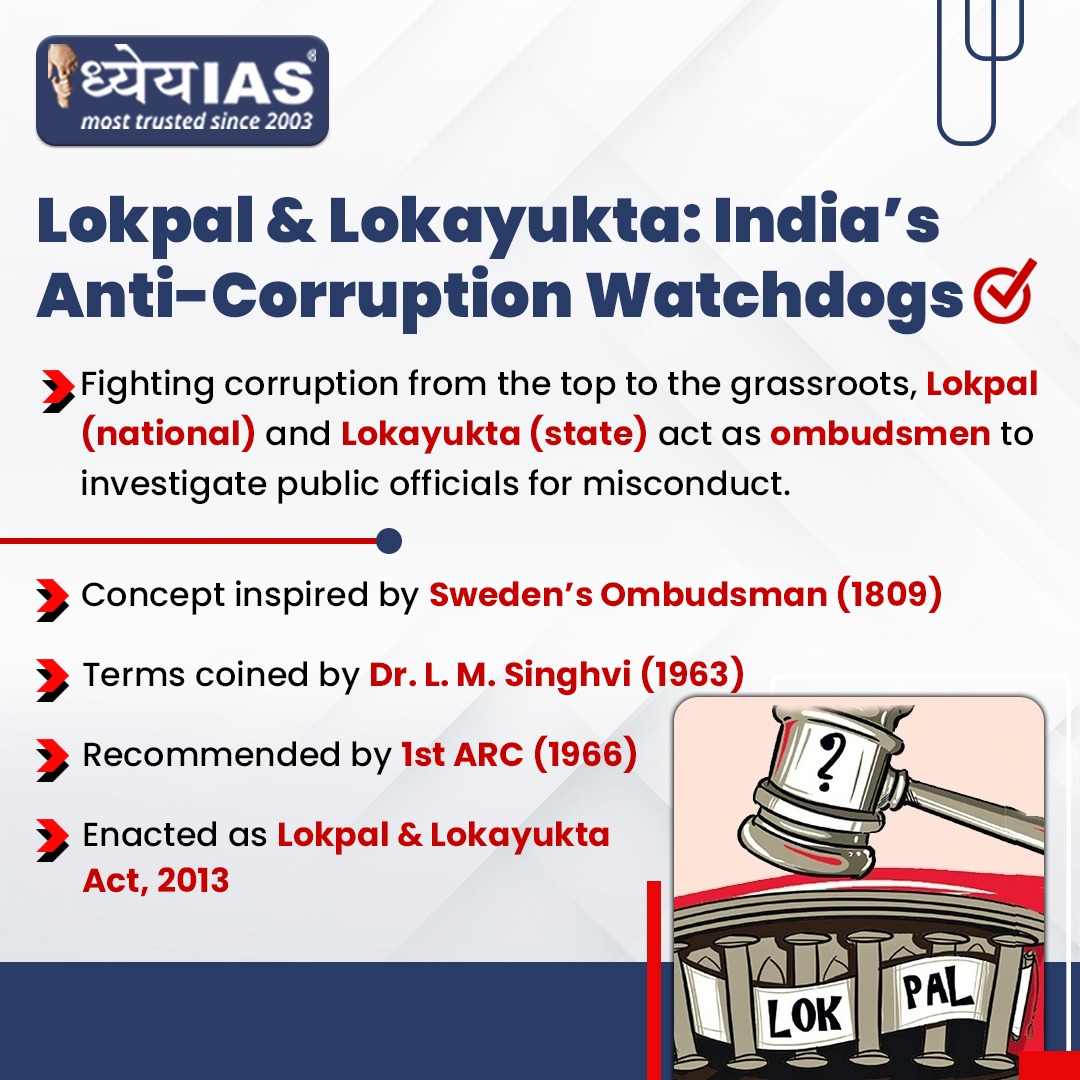Corruption remains one of the biggest challenges to good governance in India. To tackle this issue, India set up powerful institutions like the Lokpal at the national level and Lokayuktas in the states. Their job is simple yet vital: to hold public officials accountable and make sure power isn’t misused.
In a recent move, the Lokpal of India adopted a new motto: “Empower Citizens, Expose Corruption.” This isn’t just a slogan—it reflects a deeper shift toward putting citizens at the center of the anti-corruption fight. It encourages people to speak up, report wrongdoings, and demand transparency.
Lokpal and Lokayukta Act, 2013:
The Lokpal and Lokayukta Act, 2013 established:
- A Lokpal at the national level.
- Lokayuktas in each state.
Their key mandate is to investigate and address complaints of corruption against a defined category of public officials, promoting transparency and deterring misuse of power.
Important amendment (2016):
- Addressed the absence of a recognized Leader of Opposition in the Lok Sabha by letting the leader of the single-largest opposition party sit on the Lokpal selection committee.
- Strengthened asset-liability disclosure rules under Section 44, improving public servant accountability.
Structure and Jurisdiction of Lokpal:
Composition:
- Led by a Chairperson, supported by up to 8 Members.
- At least half of the Members must be Judicial Members.
- At least 50% must come from SC, ST, OBC, minority communities, and women—ensuring diverse representation.
Tenure:
- Members and Chairperson serve for 5 years or until the age of 70, whichever comes first.
Appointment Process:
- The President appoints the Lokpal based on recommendations from a Selection Committee composed of:
1. Prime Minister (Chairperson)
2. Speaker of Lok Sabha
3. Leader of Opposition / Leader of single-largest opposition party
4. Chief Justice of India or a Supreme Court judge nominated by the CJI
5. A jurist of eminence nominated by the President
This committee structure is designed to balance political and legal perspectives during appointments.
Jurisdiction:
- Central Governors of investigation include:
- Prime Minister (with restrictions on matters linked to national security or international affairs)
- Union Ministers
- Members of Parliament
- Government servants across Groups A, B, C, and D in central government
Powers and Functions of Lokpal:
The Lokpal holds significant authority aimed at ensuring effective anti‑corruption enforcement:
1. Supervise DSPE Investigations: The DSPE (formerly CBI in this role) conducts inquiries and investigations under Lokpal’s oversight.
2. Search & Seizure: It can authorize search and seizure operations to collect evidence.
3. CVC Coordination: The Central Vigilance Commission must report to Lokpal on steps taken on referred cases, and Lokpal issues guidelines to aid quick resolution.
4. Civil Court Powers: During preliminary inquiries, it wields powers similar to civil courts, thanks to provisions under Section 44 of the Code of Civil Procedure, 1908.
Role and Reach of Lokayuktas:
State-level Lokayuktas are governed by their respective state laws. While specifics vary (e.g., eligibility, appointment), their core role is consistent: to investigate corruption within state machinery.
Notable examples:
- In Uttar Pradesh, the Lokayukta exposed disproportionate asset cases involving Chief Minister Mayawati and her cabinet.
- In Karnataka, Lokayukta sting operations caught a minister accepting bribes, leading to legal fallout.
- In Delhi, the ACB (modeled on Lokayukta) conducted sting operations resulting in the arrest of corrupt government officials.
- Tamil Nadu Lokayukta investigated disproportionate asset issues, prompting disciplinary and legal actions.
Committees related to lokpal/Lokayukta:
India’s anti‑corruption drive has roots in several report committees:
1. Santhanam Committee (1962): Urged setting up independent machinery to investigate public servant corruption.
2. Law Commission, 20th Report (1967): Advocated a central agency, independent and non-political, to investigate corruption.
3. First Administrative Reforms Commission (1966–70): Recommended a two-tier ombudsman system — Lokpal at the centre and Lokayukta in states.
4. Second ARC (2005) & Ethics in Governance (2007): Called for stronger anti-corruption laws and ethical governance.
5. Parliamentary Standing Committee (2011): Influenced key provisions of the 2013 law, shaping its final draft.
6. 11th All-India Lokayukta Conference (2012): Proposed several reforms for better performance of Lokayuktas.
Current Problems in Practice:
1. Weak Protection for Complainants:
o Whistleblowers lack strong immunity.
o Section 18 allows action against a complainant if the accused is found innocent—creating fear around filing complaints.
2. Limited Appeal Provisions:
o There’s no clear mechanism to appeal Lokpal decisions, reducing transparency and accountability.
3. Political Influence:
o The Selection Committee includes political actors and an undefined “eminent jurist”—this can compromise independence.
4. Restricted Jurisdiction for PM:
o Excluding matters of national security, international relations, and atomic energy limits Lokpal’s power over the Prime Minister.
5. Other Legal Shortcomings:
o Lack of constitutional status
o No judicial purview
o Complaints dismissed after 7 years
o Opaque Lokayukta appointment methods
6. Delays in Appointments:
o Lokpal was left leaderless till March 2019—more than 5 years after the 2013 law was passed.
7. Public Awareness Is Low:
o Many citizens don’t know how Lokpal/Lokayukta function or how to file complaints.
8. Insufficient Resources:
o Understaffing and poor infrastructure limit their ability to investigate effectively.
9. Political Interference in Investigations:
o These institutions can be undermined by external pressures, eroding public trust.
10. Procedural Complexity:
o Lengthy, bureaucratic complaint procedures deter potential whistleblowers.
Suggested Solutions and Reforms:
1. Introduce Constitutional Recognition
o A constitutional amendment could secure permanent status and autonomy for Lokpal and Lokayuktas, insulating them from political manipulation.
2. Decentralization & Autonomy
o Multiple, regionally empowered institutions with strong financial and administrative independence can avoid central power concentration.
3. Reforms in Lokayukta Functioning (11th Conference, 2012):
o Position Lokayuktas as the central complaint agency for state corruption.
o Grant power over state probe agencies.
o Add bureaucrats to their remit.
o Give them search, seizure, and contempt authority.
o Ensure administrative and financial autonomy.
o Let Lokayuktas oversee government-funded NGOs.
4. Strengthen Whistleblower Protections:
o Provide immunity for complainants, even when allegations don’t result in convictions, unless part of a frivolous case.
5. Allow Appeal Rights:
o Introduce transparent mechanisms for appealing Lokpal rulings to boost accountability.
6. Clarify ‘Eminent Jurist’ Criteria:
o Define qualifications and qualifications for jurist appointees, and include judicial review of appointments.
7. Enhance Public Engagement and Resources:
o Raise public awareness about filing complaints.
o Improve infrastructure, hire competent staff, and fast-track cases.
Conclusion:
The new motto— “Empower Citizens, Expose Corruption”—is a powerful and direct call to action. It reminds citizens that the ability to hold public officials accountable starts with them.
While the 2013 Act and its amendments laid important groundwork, real impact depends on implementation:
- Safeguarding complaints and appeal rights
- Preventing political interference
- Empowering Lokpal and Lokayuktas with autonomy and resources
A constitutional overhaul and decentralization, backed by clear procedures and financial independence, would make these bodies more effective. If India wants to truly curb corruption, its anti-corruption institutions must be strong, fearless, and citizen-centric.
| Main question: What is the role of the Lokpal and Lokayuktas in fighting corruption in India? How can these institutions be made more effective? |








